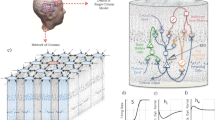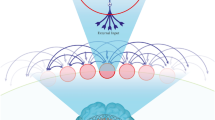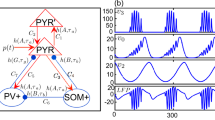Abstract
In an effort to understand basic functional mechanisms that can produce epileptic seizures, we introduce some key features in a model of coupled neural populations that enable the generation of seizure-like events and similar dynamics with the ones observed during the route of the epileptic brain towards real seizures. In this model, modified from David and Friston’s neural mass model, an internal feedback mechanism is incorporated to maintain synchronous behavior within normal levels despite elevated coupling. Normal internal feedback quickly regulates an abnormally high coupling between the neural populations, whereas pathological internal feedback can lead to hypersynchronization and the appearance of seizure-like high amplitude oscillations. Feedback decoupling is introduced as a robust seizure control strategy. An external feedback decoupling controller is introduced to maintain normal synchronous behavior. The results from the analysis in this model have an interesting physical interpretation and specific implications for the treatment of epileptic seizures. The proposed model and control scheme are consistent with a variety of recent observations in the human and animal epileptic brain, and with theories from nonlinear systems, adaptive systems, optimization, and neurophysiology.
Similar content being viewed by others
References
Abbott LF, Varela JA, Sen K, Nelson SB (1997) Synaptic depression and cortical gain control. Science 275(5297):221–224
Astrom KJ, Rundqwist L (1989) Integrator windup and how to avoid it. In: Proceedings of the 1989 American control conference, Pittsburgh, PA, USA, 21–23 June 1989, pp 1693–1698
Bartolomei F, Wendling F, Bellanger JJ, Regis J, Chauvel P (2001) Neural networks involving the medial temporal structures in temporal lobe epilepsy. Clin Neurophysiol 112(9):1746–1760
Breakspear M, Roberts JA, Terry JR, Rodrigues S, Mahant N, Robinson PA (2006) A unifying explanation of primary generalized seizures through nonlinear brain modeling and bifurcation analysis. Cereb Cortex 16(9):1296–1313
Bush PC, Prince DA, Miller KD (1999) Increased pyramidal excitability and NMDA conductance can explain posttraumatic epileptogenesis without disinhibition: a model. J Neurophysiol 82(4):1748–1758
Carlson JM, Doyle J (1999) Highly optimized tolerance: a mechanism for power laws in designed systems. Phys Rev E 60(2):1412–1427
Chakravarthy N (2007) A feedback systems perspective for modeling and controlling epileptic seizures. PhD thesis, Arizona State University
Chakravarthy N, Sabesan S, Iasemidis LD, Tsakalis K (2007) Modeling and controlling synchronization in a neuron-level population model. Int J Neural Syst 17(2):123–138
Chawla D, Lumer ED, Friston KJ (1999) The relationship between synchronization among neuronal populations and their mean activity level. Neural Comput 11(6):1389–1411
Cline H (2005) Synaptogenesis: a balancing act between excitation and inhibition. Curr Biol 15(6):203–205
Contreras D, Destexhe A, Steriade M (1997) Intracellular and computational characterization of the intracortical inhibitory control of synchronized thalamic inputs in vivo. J Neurophysiol 78(1):335–350
David O, Friston KJ (2003) A neural mass model for MEG/EEG: coupling and neuronal dynamics. NeuroImage 20(3):1743–1755
Desai NS, Rutherford LC, Turrigiano GG (1999) Plasticity in the intrinsic excitability of cortical pyramidal neurons. Nat Neurosci 2:515–520
Desai NS, Cudmore RH, Nelson SB, Turrigiano GG (2002) Critical periods for experience-dependent synaptic scaling in visual cortex. Nat Neurosci 5(8):783–789
Doyle J, Carlson JM (2000) Power laws, highly optimized tolerance, and generalized source coding. Phys Rev Lett 84(24):5656–5659
Freeman WJ (1987) Simulation of chaotic EEG patterns with a dynamic model of the olfactory system. Biol Cybern 56(2–3):139–150
Giannakopoulos F, Bihler U, Hauptmann C, Luhmann HJ (2001) Epileptiform activity in a neocortical network: a mathematical model. Biol Cybern 85(4):257–268
Golowasch J, Casey M, Abbott LF, Marder E (1999) Network stability from activity-dependent regulation of neuronal conductances. Neural Comput 11(5):1079–1096
Grassi E, Tsakalis KS, Dash S, Gaikwad SV, MacArthur W, Stein G (2001) Integrated system identification and PID controller tuning by frequency loop-shaping. IEEE Trans Control Syst Technol 9(2):285–294
Grimbert F, Faugeras O (2006) Bifurcation analysis of Jansen’s neural mass model. Neural Comput 18(12):3052–3068
Houweling AR, Bazhenov M, Timofeev I, Steriade M, Sejnowski TJ (2005) Homeostatic synaptic plasticity can explain post-traumatic epileptogenesis in chronically isolated neocortex. Cereb Cortex 15(6):834–845
Iasemidis LD (2003) Epileptic seizure prediction and control. IEEE Trans Bio-Med Eng 50(5):549–558
Iasemidis LD, Sackellares JC (1991) The temporal evolution of the largest Lyapunov exponent on the human epileptic cortex. In: Duke D, Pritchard W (eds) Measuring chaos in the human brain. World Scientific, Singapore, pp 49–82
Iasemidis LD, Prasad A, Sackellares JC, Pardalos PM, Shiau DS (2001) On the prediction of seizures, hysteresis and resetting of the epileptic brain: insights from models of coupled chaotic oscillators. In: Bountis T, Pneumatikos S (eds) Order and chaos. Proceedings of the 14th summer school on nonlinear dynamics: chaos and complexity, Patras, Greece, 2001, vol 8. Publishing House of K. Sfakianakis, Thessaloniki, pp 283–305
Iasemidis LD, Shiau DS, Chaovalitwongse W, Sackellares JC, Pardalos PM, Principe JC, Carney PR, Prasad A, Veeramani B, Tsakalis K (2003) Adaptive epileptic seizure prediction system. IEEE Trans Bio-Med Eng 50(5):616–627
Iasemidis LD, Shiau DS, Sackellares JC, Pardalos PM, Prasad A (2004) Dynamical resetting of the human brain at epileptic seizures: application of nonlinear dynamics and global optimization techniques. IEEE Trans Bio-Med Eng 51(3):493–506
Iasemidis L, Pardalos PM, Shiau DS, Chaovalitwongse W, Narayanan K, Prasad A, Tsakalis K, Carney P, Sackellares JC (2005a) Long term prospective on-line real-time seizure prediction. J Clin Neurophysiol 116:532–544
Iasemidis L, Tsakalis K, Sackellares JC, Pardalos PM (2005b) Comment on ‘Inability of Lyapunov exponents to predict epileptic seizures. Phys Rev Lett 94:019,801
Jansen BH, Rit VG (1995) Electroencephalogram and visual evoked potential generation in a mathematical model of coupled cortical columns. Biol Cybern 73(4):357–366
Jansen BH, Zouridakis G, Brandt ME (1993) A neurophysiologically-based mathematical model of flash visual evoked potentials. Biol Cybern 68(3):275–283
Kudela P, Franaszczuk PJ, Bergey GK (2003) Changing excitation and inhibition in simulated neural networks: effects on induced bursting behavior. Biol Cybern 88(4):276–285
Kudela P, Franaszczuk PJ, Bergey GK (2004) Synaptic plasticity in neuronal network models can explain patterns of bursting activity seen in temporal lobe epileptic seizures. In: 2004 EMBC 2004 conference proceedings 26th annual international conference of the 1. Engineering in Medicine and Biology Society
Larter R, Speelman B, Worth RM (1999) A coupled ordinary differential equation lattice model for the simulation of epileptic seizures. Chaos 9(3):795–804
LeMasson G, Marder E, Abbott LF (1993) Activity-dependent regulation of conductances in model neurons. Science 259(5103):1915–1917
Liley DTJ, Bojak I (2005) Understanding the transition to seizure by modeling the epileptiform activity of general anesthetic agents. J Clin Neurophysiol 22(5):300–313
Liley DTJ, Cadusch PJ, Wright JJ (1999) A continuum theory of electro-cortical activity. Neurocomputing 26(7):795–800
Liley DTJ, Cadusch PJ, Dafilis MP (2002) A spatially continuous mean field theory of electrocortical activity. Netw Comput Neural Syst 13(1):67–113
Lopes da Silva FH, Hoeks A, Smits H, Zetterberg LH (1974) Model of brain rhythmic activity: the alpha-rhythm of the thalamus. Kybernetik 15(1):27–37
Lytton WW, Contreras D, Destexhe A, Steriade M (1997) Dynamic interactions determine partial thalamic quiescence in a computer network model of spike-and-wave seizures. J Neurophysiol 77(4):1679–1696
McCormick DA, Contreras D (2001) On the cellular and network bases of epileptic seizures. Annu Rev Physiol 63:815–846
Miller KD, MacKay DJC (1994) The role of constraints in Hebbian learning. Neural Comput 6:100–124
Mountcastle VB (1997) The columnar organization of the neocortex. Brain 120(4):701–722
Nelson SB, Turrigiano GG (1998) Synaptic depression: a key player in the cortical balancing act. Nat Neurosci 1:539–541
O’Brien RJ, Kamboj S, Ehlers MD, Rosen KR, Fischbach GD, Huganir RL (1998) Activity-dependent modulation of synaptic AMPA receptor accumulation. Neuron 21(5):1067–1078
Park EH, Durand DM (2006) Role of potassium lateral diffusion in non-synaptic epilepsy: a computational study. J Theor Biol 238(3):666–682
Robinson PA, Rennie CJ, Rowe DL (2002) Dynamics of large-scale brain activity in normal arousal states and epileptic seizures. Phys Rev E 65(4):41924
Sabesan S, Narayanan K, Prasad A, Spanias A, Sackellares J, Iasemidis L (2003) Predictability of epileptic seizures: a comparative study using Lyapunov exponent and entropy based measures. Biomed Sci Instrum 39:129–135
Schnitzler A, Gross J (2005) Normal and pathological oscillatory communication in the brain. Nat Rev Neurosci 6:285–296
Stoegbauer H, Yang L, Grassberger P, Andrzejak RG, Kreuz T, Kraskov A, Elger CE, Lehnertz K (2002) Lateralization of the focal hemisphere in mesial temporal lobe epilepsy using independent component analysis. Epilepsia 43:51
Suffczynski P, Kalitzin S, Da Silva FHL (2004) Dynamics of non-convulsive epileptic phenomena modeled by a bistable neuronal network. Neuroscience 126(2):467–484
Suffczynski P, Wendling F, Bellanger JJ, Lopes Da Silva FH (2006) Some insights into computational models of (patho) physiological brain activity. Proc IEEE 94(4):784–804
Traub RD, Miles R (1991) Neuronal networks of the hippocampus. Cambridge University Press, London
Traub RD, Contreras D, Whittington MA (2005) Combined experimental/simulation studies of cellular and network mechanisms of epileptogenesis in vitro and in vivo. J Clin Neurophysiol 22(5):330–342
Tsakalis K, Iasemidis LD (2006) Control aspects of a theoretical model for epileptic seizures. Int J Bifurc Chaos 16(7):2013–2027
Tsakalis K, Chakravarthy N, Iasemidis LD (2005) Control of epileptic seizures: models of chaotic oscillator networks. In: 44th IEEE conference on decision and control, pp 2975–2981
Tsakalis K, Chakravarthy N, Sabesan S, Iasemidis LD, Pardalos PM (2006) A feedback control systems view of epileptic seizures. Cybern Syst Anal 42(4):483–495
Turrigiano GG (1999) Homeostatic plasticity in neuronal networks: the more things change, the more they stay the same. Trends Neurosci 22(5):221–227
Turrigiano GG, Nelson SB (2000) Hebb and homeostasis in neuronal plasticity. Curr Opin Neurobiol 10(3):358–364
Turrigiano GG, Nelson SB (2004) Homeostatic plasticity in the developing nervous system. Nat Rev Neurosci 5(2):97–107
Turrigiano GG, Leslie KR, Desai NS, Rutherford LC, Nelson SB (1998) Activity-dependent scaling of quantal amplitude in neocortical neurons. Nature 391(6670):892–896
Wendling F, Bellanger JJ, Bartolomei F, Chauvel P (2000) Relevance of nonlinear lumped-parameter models in the analysis of depth-EEG epileptic signals. Biol Cybern 83(4):367–378
Wendling F, Bartolomei F, Bellanger JJ, Chauvel P (2001) Interpretation of interdependencies in epileptic signals using a macroscopic physiological model of the EEG. Clin Neurophysiol 112(7):1201–1218
Wendling F, Bartolomei F, Bellanger JJ, Chauvel P (2002) Epileptic fast activity can be explained by a model of impaired gabaergic dendritic inhibition. Eur J Neurosci 15(9):1499–1508
Wendling F, Hernandez A, Bellanger JJ, Chauvel P, Bartolomei F (2005) Interictal to ictal transition in human temporal lobe epilepsy: insights from a computational model of intracerebral EEG. J Clin Neurophysiol 22(5):343–356
Yang KH, Franaszczuk PJ, Bergey GK (2005) Inhibition modifies the effects of slow calcium-activated potassium channels on epileptiform activity in a neuronal network model. Biol Cybern 92(2):71–81
Author information
Authors and Affiliations
Corresponding author
Rights and permissions
About this article
Cite this article
Chakravarthy, N., Sabesan, S., Tsakalis, K. et al. Controlling epileptic seizures in a neural mass model. J Comb Optim 17, 98–116 (2009). https://doi.org/10.1007/s10878-008-9182-9
Published:
Issue Date:
DOI: https://doi.org/10.1007/s10878-008-9182-9




